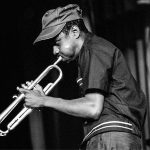Bridging the black Atlantic in jazz
The collaboration of Zimbabwean musician Thomas Mapfumo and African American jazz trumpeter Ishmael Wadada Leo Smith, broke new ground and should have grown cult status.
Author:
31 October 2019

The example of the reunification of Germany is instructive when thinking about the time, 20 years ago, when two great projects to bridge the black Atlantic were created: Manhungetunge and Dreams and Secrets by Zimbabwean musician Thomas Mapfumo and African American jazz trumpeter Ishmael Wadada Leo Smith.
There was always the fear that the longer the reunification of East and West Germany took, the less likely it would be that Germany would be able to revert to being truly one nation again. Even though they shared a language, the different socioeconomic and political trajectories the two had taken since the partition worked against the idea of one nationhood.
At first glance, just like the Germans who were separated after World War II and reunited only when the wall fell in 1989, a collaboration between chimurenga music maestro Mapfumo and avant-garde jazz master Smith is one that should not have worked. It might be because hundreds of years ago, Smith’s ancestors were sold by fellow Africans to European slave traders who then took them to the United States. It also might be because the trumpeter belonged to the free jazz movement, a strand of the music with a limited listenership, while Mapfumo’s singular achievement involved electrifying and popularising the mbira, an instrument normally associated with the ancient spiritual rituals of his people, the Shona.
Yet, on further reflection, the two musicians have a lot in common; they are both children of the 1940s (Smith was born in 1941 and Mapfumo in 1945) and their work is steeped in the blues. What, after all, is mbira music if it is not blues music – the blues of the ancestors. Smith himself says: “The blues was my first language and it never went away.”
Both musicians have shown an interest in reggae. Mapfumo started experimenting with that sound on his 1985 album Chimurenga for Justice and is rightly considered the godfather of ZimDancehall, while Smith became Rastafarian in the 1980s and legally added Wadada (Swahili for love) to his name.
Unencumbered by tradition
However worldly and urban they may be, both spent their formative years under the skies of rural landscapes (Smith grew up in the Mississippi Delta and Mapfumo was partly raised by his grandparents in Chihota Tribal Trust Land, a rural area not far from Harare, where he first became familiar with mbira music). Yet although Smith was raised in a rural setting, his music, in the words of American critic Adam Shatz, was “less encumbered by traditional song forms”, even if it evoked a “pastoral modernism: spacious, serene, and in no hurry to reach its destination”.
These two traits – being “unencumbered by traditional song forms” and the “pastoral modernism” – are especially crucial for their collaborative work. While Mapfumo’s music also evokes a pastoral modernism, there is a paradoxical aesthetic at once bound by and yet rebellious to traditional song forms. Take, for instance, his ditty Hanzvadzi on the 1993 album Vanhu Vatema, his reinterpretation of the mbira classic Nhemamusasa. Mapfumo’s version of the song is stripped away of the primal energy and rustic accents of what has been said to be the first song to be laid down after the Shona first settled in (or from) Guruuswa, the mythical place of origin for the Shona, where the grasses grow lush and long.
Related article:
In less capable hands, what would have remained after this stripping down would have been a bastardised, hollowed out standard, but this wasn’t the case with Mapfumo’s take on Nhemamusasa. Instead, what Mapfumo set down is a beautiful, bluesy song that gestures at the melodies, the landscapes, lyrics and the influences from which it is descended without being slavishly bound to the ancestor song.
The delicacy of their act of bridging the Atlantic is perhaps best illustrated in the fact that when the two eventually collaborated, the Zimbabwean and the American made two separate projects: Mapfumo’s project was titled Manhungetunge and Smith’s album was Dreams and Secrets. Even though a few songs, such as Big in America, Marimuka, The Zambezi River (on Mapfumo’s album the song is titled Manhungetunge) are common on both albums, the two projects are quite separate.
About the collaboration, Smith said that the connection with Mapfumo and his band had been a “magnificent moment for me”, one that “made me realise how to think about the link between me and Africa, between African American people and Africa”.
Birth of the idea
Based in Eugene, Oregon, in the US, Mapfumo explained the origins of the idea. He said he had been linked to Smith by Thomas Allen Green, a New York-born jazz rock fusion musician and the owner of an independent label that, among other projects, published and promoted the Zimbabwean’s work in the US. It was Green who helped Mapfumo, his family and band relocate to the US in the early 2000s.
Mapfumo says his and Wadada’s band went to the Gung Ho studios in Eugene, where they played together. Mapfumo added his vocals on some of Smith’s compositions and the trumpeter and his band feature on the Zimbabwean’s compositions.
Recalling the creative process, Smith says, “We recorded in Eugene, Oregon, in a studio that could house both bands and during our breaks we would go and pick and eat blackberries that ran along the back fence, and smoke. We had a beautiful time. Often we sat on the porch together and, after saying ‘hello’, we would sit and dream together, without saying a word. We were both dreaming of how to make this work.”
Decades before the two musicians collaborated, Smith was already gesturing towards his later collaboration. On his classic 1979 ECM record Divine Love – when he was still known only as Leo Smith, before he converted to Islam and before he added the names Wadada and Ishmael to his birthname – Smith featured the saxophonist Dwight Andrews who, among other instruments, played the mbira on some tracks.
He had featured on that album playing what are sometimes called in ethnomusicology “tribal” or “ethnic” instruments, categorisations the trumpeter dismissed outright. “I believe that there is no such thing as ‘tribal’ instruments. All these instruments are just like human beings, they are equal to each other,” he says.
Related article:
“When I use the mbira, I use the mbira knowing that the mbira has a connection to me and my ancestors across Africa. It’s the only instrument that we can point to today that hasn’t gone through any innovation. It’s just like what it was when it was first made. It’s decorated differently, stuff has been added to it, but the sounding board and the metallic keys affixed to it were there when it was first made. It’s the instrument with which my ancestors could easily travel with and one through which they could entertain themselves when they needed to.”
Neither of the musicians found the collaboration difficult. This was because, says Smith, “musicians around the world are some of the most international people and often they play with other musicians from different places and languages”.
It was a point echoed by Mapfumo, who says before he started playing his own music, in the late 1970s, he had made a name playing covers of songs done by bands and performers such as the Rolling Stones, The Beatles, Chicago Transit Authority, Frank Sinatra, Franco Luambo, Sam Cooke and others on the nightclub scene of Southern Rhodesia. “We used to play jazz standards in the night clubs in which we were contracted to play. Before we moved on to playing popular dance music, we would play jazz.”
Smith explains that crucial in both projects was how to mix the mbira and the electric guitar. Coincidentally, this had been a long-running concern of Mapfumo’s: when he and his long-time collaborator, the late Jonah Sithole, sat down decades ago to create chimurenga music, one overriding concern was how to create the mbira sound on guitar.
Balance and respect
Talking generally about the project, Smith says, “What we were thinking about was how to use them [the musicians] in the best way and not to ask them to do something not specific to their traditions, in fact use that tradition and merge those two musics and come out with one. That’s often not done very well, but I love how our projects achieved a good sense of balance and respected the idea of how music should be created.”
Smith also recalls the late mbira player Ngoni Makombe coming to him to say, “Wadada, I don’t know what it is, but when I play your music, I see the melody that you gave me, but once I start playing it I hear other melodies that go with it.”
Manhungetunge is arguably one of the best albums by Mapfumo and yet in Zimbabwe the offering is not as highly regarded as the Zimbabwean’s other classic records such as Chimurenga for Justice and the 1989 workers’ manifesto Varombo kuVarombo, while Dreams and Secrets is virtually unknown. Smith explains this situation: “Whenever one seeks to open up a new avenue in musical expression, there is always a limited amount of people who are able to understand it.”
It’s a pity that the Mapfumo album hasn’t achieved the cult status it rightly deserves, for there is a certain assuredness on the Manhungetunge album, as if Mapfumo was walking with a spring in his step. Creatively, it is Mapfumo at his most ambitious and experimental, actively courting jazz and rock tropes and merging them with the rebellious, heady accents of chimurenga, the Zimbabwean word (as opposed to Shona), for revolutionary struggle. On the 10-song album, all but two songs are more than five minutes in length, giving the musicians space on which to play. The meditative, searching song Marimuka, perhaps the most accomplished of their collaborations, is nearly 12 minutes.
Related article:
Similarly, Dreams and Secrets (some have made comparisons of this album to the electric Miles Davis) is an album of sublime beauty. On the song Masimba the two show that the mbira and blues have a common ancestor while on the tune Lamar and N’dasia Steppin’ shows that the frenetic, energy sonic is drawn from the deep depths of the blues.
Dreams and Secrets and Manhungetunge are great specimens of the delicate exercise of bridging the black Atlantic.
Thomas Mapfumo is playing on Saturday 2 November at Ekurhuleni Boksburg Hotel, 14 Church St, Boksburg East. In September 2020, Wadada Leo Smith will begin a series of South African concerts, workshops and lectures to commemorate the life of the composer and bassist Johnny Dyani, who died in exile in West Berlin in October 1986, and with whom he collaborated. Smith’s 2009 album, Abbey Road Quartet, features two songs, For Johnny Dyani and For Mongezi Feza, dedicated to the two late South African jazz maestros. The two-week series will begin in East London, where Dyani was born, and then head to Cape Town and Durban, before ending in Johannesburg.



